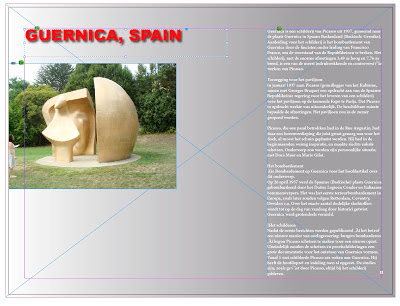.
De plug-in van em-software die het mogelijk maakt Word-bestanden met behoud van opmaak in InDesign te 'round trippen' met wijzigingen (een simpel, beperkt, alternatief voor InCopy in eenvoudige workflows) is nu te koop.
Van de em-software site:
Basics
User interface
WordsFlow normally works within InDesign’s existing file linking/updating user interface machinery. You use the Links palette functions as you would before for graphic files, but now WordsFlow enables the same update/relink/edit original/etc functionality for text files.
When WordsFlow starts up for the very first time after installation, it turns on the global InDesign preference Preferences > File Handling > Create Links When Placing Text and Spreadsheet Files, but you’re free to set it on or off, depending on whether you’d like placements to involve WordsFlow support by default (when on) or not (when off).
When this Create Links global preference is on, then WordsFlow works behind the scenes for all normal InDesign text/spreadsheet file placement (File > Place…, file drag and drop, etc.) And, WordsFlow adds a new File > Place without WordsFlow… menu item so you can place a file without WordsFlow involvement.
When this Create Links global preference is off, WordsFlow doesn’t involve itself in the default text/spreadsheet file placement process. In this case, the WordsFlow menu becomes File > Place with WordsFlow…, so you can explicitly invoke it only when you need it.
WordsFlow also exposes both File alternate menu items Place with WordsFlow… and Place without WordsFlow… to the keyboard shortcut machinery. That way, you can assign appropriate shortcuts that best fit your workflow, independently of the global Create Linkspreference.
 WordsFlow has its own menu under Help, with entries for visiting (in the browser) this user guide, the main product page, product news, sending an email to support (with version information filled in), and About… to show the WordsFlow version and license information.
WordsFlow has its own menu under Help, with entries for visiting (in the browser) this user guide, the main product page, product news, sending an email to support (with version information filled in), and About… to show the WordsFlow version and license information.
Style mapping
Although WordsFlow itself doesn’t do any style mapping, you can bring up InDesign’s style mapping options for a Word document when you place it using File > Place… and checking theShow Import Options checkbox, then selecting Custom Style Mapping.
Workflow
(Below, we’ll use the term “author” for both author and editor, i.e., anyone who’s working with a source Word or Excel file.)
If you need to make non-trivial edits to a story after you’ve received and placed it, and expect further changes from the author, you’re probably well-advised to make those changes in the original Word or Excel file (you can use Edit Original from the Links palette). That way, you can send back your changes in the original source format to the author before they make any further edits. Of course, you’re free to make any edits to the InDesign story directly, as well, but those won’t be sharable with the author, as InDesign can’t export Word or Excel formats.
Using email/file-sharing sites
If you work by sending and receiving Word/Excel files from authors using email or file-sharing sites, then things would work best with WordsFlow by gathering all relevant files into a single folder for your current publication. That way, when you’re sent a new version of a file you’ve already placed (via email or a new download from a file-sharing site), you can simply replace (copy over) the old version with the new, and InDesign will notice the change and allow you to update-merge with WordsFlow. Or, if they’ve changed the file name in the new version (e.g., by appending a revision number), you can relink the story to the newest file (which will also trigger a merge-update).
Using filesystem-sharing solutions
Perhaps the best method for working with authors using Word/Excel files would be to use a filesystem-sharing solution like Dropbox, Box, Google Drive, Microsoft SkyDrive, etc. If you establish and share a new shared folder for each publication with the authors on your team, you can directly place files into InDesign from that folder, they can edit them in place, and when you see they’ve updated the file via the link status changing, you can update-merge immediately from InDesign. Further, you can edit the shared file yourself if you need to make major edits, and those will be seen by everyone else on the team.
(Of course, you may have to use some kind of email or instant messaging communication channel to alert each other what the state of a given file is; if someone’s actively editing for a while, you don’t want anyone else to edit it, nor do you want to merge-update the file in InDesign until they’re done with their current edits.)
Appendix: Merge-update operation
Each time you update a story from a external linked text file, WordsFlow (behind the scenes) performs a merge-update rather than simply letting InDesign replace the story contents.
WordsFlow looks at the previous state of the external file (privately saved in the InDesign document) and the current state of the external file, and computes the “difference” between the two, to get the current set of changes to be applied. Then, WordsFlow applies those differences and updates the current InDesign story by merging in the differences.
When there are conflicts, the InDesign story “wins” over the external source file changes. E.g., if you delete some text in InDesign, but the text is kept in the external file, it remains deleted after an update.
Of course, WordsFlow can’t read your mind. For example, if you styled a couple of paragraphs in InDesign, and the editor added some more paragraphs after the original two in the text file, you may or may not want those additional paragraphs to be styled the same. So you’ll always have to check after a merge, but at least you won’t have to do the tedious and error-prone work of merging manually.







